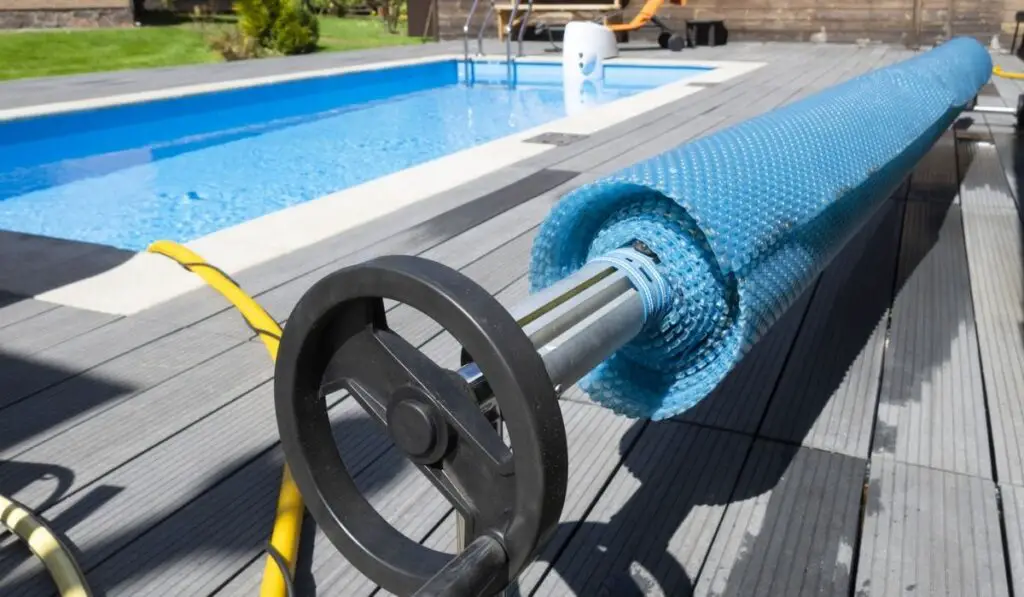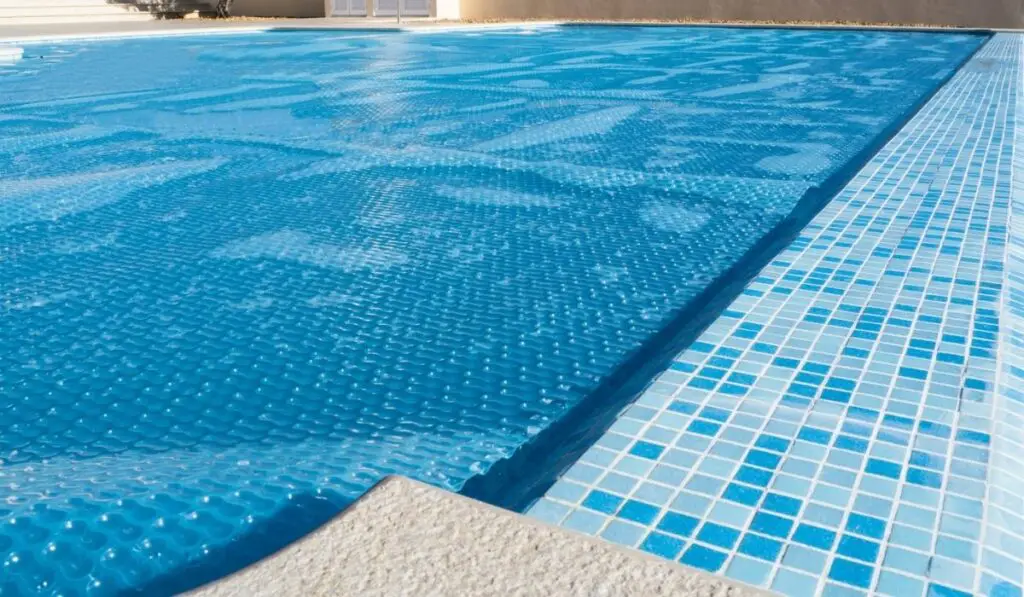Solar pool covers are designed to absorb the sun’s rays and transfer that heat to the water. Additionally, solar pool covers can help reduce evaporation. Many people own one of these covers, but few understand exactly how it works or whether they should leave it on the pool all day long.
In hot climates, you may want to leave a solar pool cover on to minimize evaporation and retain heat. In colder areas, you can remove the cover during the day so that it absorbs the sun’s rays, and then replace it at night. Leaving them on all day is more a matter of personal preference.
Let’s take a closer look at how solar pool covers work so that you can decide when it’s best to leave yours on or take it off. We’ll also look at different types of covers and how to care for one properly, so that you can make the decision that’s best for you and also know how to maintain your pool system over time!
What Are Solar Pool Covers?

Solar pool covers are large plastic sheets placed over the surface of a swimming pool to help retain heat for a pleasant swimming experience. The cover is usually held in place with a pool cover reel or another type of fastener.
As the sun’s rays hit the cover, they are absorbed and turned into heat energy. This heat is then transferred to the water below, raising the temperature of the water.
While leaving your pool uncovered during a hot day can raise the temperature of the water, much of the warmth is lost through evaporation. A solar pool cover can help prevent this heat loss by trapping the warmth beneath the surface.
Additionally, pool covers help prevent water loss that occurs from evaporation, especially during hot and windy conditions, and they keep debris from falling into the pool.
Different Types of Solar Pool Covers
There are two main types of solar pool covers: bubble wrap and solid. Bubble wrap covers (on Amazon) are less expensive but don’t last as long as solid covers. They are made of transparent plastic material with bubbles embedded throughout.
These bubbles serve two purposes: retaining heat and providing insulation. The bubbles also make the cover lighter and easier to handle than a solid cover.
Solid solar covers are made of a thicker, more durable material. They are more expensive, but they last longer and provide better insulation.
Solid covers are available in various colors, including blue, green, and black. Black solar blankets are the most effective at absorbing heat, but they can make your pool look dark and uninviting.
Pool covers also come in various sizes, material densities, and shapes to fit any pool. They can also be cut to fit irregularly shaped pools. When deciding on a solar pool cover, consider the climate of your area and the season.
If you live in a hot climate, you’ll want a cover that can withstand high temperatures. In cooler climates, you’ll want a cover that can retain heat. Be sure to measure your pool and choose a slightly larger cover. This will ensure that the cover fits snugly over the pool’s surface and doesn’t come loose unexpectedly.
Benefits of Solar Pool Covers
Solar pool covers offer several benefits, including reducing evaporation, heating the water, and keeping the pool clean.
1. Reducing Evaporation
One of the main benefits of solar pool covers is reducing evaporation. When water evaporates, it takes heat with it, causing the temperature of the water to drop.
A solar pool cover helps trap heat beneath the water’s surface, preventing it from escaping. This can save you money on your energy bill by reducing the time you need to run your pool heater.
2. Heating the Water
Solar pool covers are an efficient way to heat your pool. As the sun’s rays hit the cover, they are absorbed and turned into heat energy. This heat is then transferred to the water below, raising the temperature of the water. The cover acts as a barrier, trapping the heat beneath the surface of the water.
3. Keeping the Pool Clean
Solar pool covers also help keep your pool clean by preventing leaves and other debris from falling into the water. When you remove a solar cover, you’ll find that your pool is cleaner than it would be if it was left uncovered.
Should a Solar Pool Cover Be Left on During the Day?

Solar pool covers can be left on during the day, but it’s not always necessary. If you live in a hot climate, you may want to leave the cover on during the day to prevent the water from evaporating.
In cooler climates, you can remove the blanket during the day to allow the sun’s rays to warm the water and then put the cover back on at night to retain the heat. You don’t need a solar cover during the winter. Instead, you can use a simple protective cover to keep your pool clean and prevent leaves from falling in.
Solar covers are also helpful in the spring and fall when the weather is cool, and you want to extend the swimming season.
There are times when a solar cover is not appropriate. To avoid damage from debris, remove the cover during severe weather and wind events. You should also take off the blanket before shocking the pool, and leave it uncovered until chlorine levels drop below 2.5 ppm.
A pool cover might be dangerous to children and pets, so make sure the pool area is kept clear while the pool cover is in place to avoid accidents. Installing a reel system can make it easy to remove and store the cover when it’s not in use.
How to Care for a Solar Pool Cover
Solar pool covers are durable, but they are still prone to damage from high chlorine levels, unbalanced water pH levels, and poor handling. They should not be used after super-chlorinating the pool until the chlorine level drops to lower than 2.5 ppm. Soft water with calcium levels below 150 ppm can turn the solar cover crispy and rigid.
Solar blanket reels (on Amazon) prevent the cover from folding and pitching as well as make the cleaning process more manageable. The solar pool cover should be rinsed with fresh water after every use and stored in a cool, dry place. Don’t store the cover in direct sunlight as this can damage the material.
The cover should be removed and stored indoors during the winter to prevent it from becoming brittle and breaking. But before doing so, make sure to clean and dry it first to prevent mold and mildew from growing.
Store the solar cover in a large Rubbermaid bin or a similar container to protect it from rodents. If you have more than one solar cover, store them in different bins to prevent them from sticking together.
If you live in an area with severe winters, you may consider investing in a solar cover storage bag. These bags are made from durable material that can withstand cold weather and keep your solar covers in good condition.
